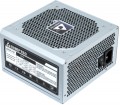PFC
The type of power factor correction (PFC) provided in the power supply.
The power consumed by the PSU is divided into
active and reactive; the first goes to perform useful work, the second does not produce such work and is dissipated in the form of heat. The power factor is the ratio of active power to the total power consumed; the closer it is to one, the more efficient the PSU.
PFC correction is applied to improve the power factor. It can be done passively or actively. The first option provides the presence of a coil (choke), which partly compensates for the operation of the reactive components of the PSU; such a correction is simple and inexpensive to implement, but not very effective. The active method, in turn, provides the presence of a specialized controller. It is more expensive, but the power factor in such PSUs can reach 0.95 or more; in addition, the device is more resistant to voltage drops.
In general, for use in a home or small office, passive correction is more than enough; active PSUs should be specifically looked for mainly in cases where we are talking about numerous computers connected to a powerful UPS.
Efficiency
Efficiency, in this case — the ratio of the power of the power supply (see "Power") to its power consumption. The higher the efficiency, the more efficient the power supply, the less energy it consumes from the network at the same output power, and the cheaper it is to operate. Efficiency may differ depending on the load; the characteristics can indicate both the minimum efficiency and its value at an average load (50%).
It should be noted that compliance with one or another level of 80PLUS efficiency directly depends on this indicator (for more details, see "Certificate").
ATX12V version
A standard for power supplies that supplements the ATX specifications regarding power supply along the 12 V line. Introduced into use since the time of the Intel Pentium 4 processor. In the first series of the standard, the +5 V line was mainly used; from version 2.0, the +12 V line was introduced to fully power the components computer. Also in the second generation, a 24-pin power connector appeared, used in most modern motherboards.
SATA
The number of SATA power connectors provided in the PSU.
Nowadays, SATA is the standard interface for connecting internal hard drives, and it is also found in other types of drives (SSD, SSHD, etc.). Such an interface consists of a data connector connected to the motherboard, and a power connector connected to the PSU. Accordingly, in this paragraph we are talking about the number of SATA power plugs provided in the PSU. This number corresponds to the number of SATA drives that can be simultaneously powered from this model.
MOLEX
The number of Molex (IDE) connectors provided in the design of the power supply.
Initially, such a connector was intended to power peripherals for the IDE interface, primarily hard drives. And although the IDE itself is completely obsolete today and is not used in new components, however, the Molex power connector continues to be installed in power supplies, and almost without fail. Almost any modern PSU has at least
1 – 2 of these connectors, and in high-end models this number can be
7 or more. This situation is due to the fact that Molex IDE is a fairly universal standard, and with the help of the simplest adapters, components with a different power interface can be powered from it. For example, there are Molex - SATA adapters for drives, Molex - 6 pin for video cards, etc.
Noise level
The noise level produced by the power supply.
Usually, the characteristics indicate the average value of the noise level during normal operation. The lower this value, the quieter the power supply and the more comfortable it is to use. However, it is worth noting that modern computer PSUs produce very little noise. So, in the quietest models, this figure
does not exceed 20 dB — this is no louder than the rustling of leaves in a light breeze, such a sound is almost inaudible and is quite acceptable even in a residential area at night. Also acceptable for this application are noise sources of
21 – 25 dB(corresponding to a whisper at a distance of about 1 m) and
26 – 30 dB(wall clock ticking). Noise
of more than 30 dB is already considered quite significant for computer PSUs; according to sanitary standards, such equipment in residential premises can only be used during the day.
When choosing a power supply for this indicator, it is worth considering a few points. First, noise reduction comes at a cost: it can affect the cooling performance and/or cost of the device. Secondly, the noise from the power supply is often lost against the background of louder PC components — for example, powerful cooling systems for the CPU or graphics card. Thirdly, the very environment where the PC is installed can be noisy — an example is a
...n office or coworking. Thus, specifically looking for a low-noise model makes sense mainly in cases where maximum silence is crucial for you.
